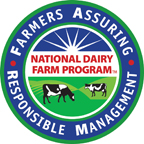Plan is Better for Farmers and Workers, According to NMPF
ARLINGTON, VA – The Senate Thursday approved a comprehensive immigration reform measure that will help dairy farmers with their current and future workforce needs, and provide the entire agriculture sector with much-needed economic certainty, according to the National Milk Producers Federation.
“We’ve known for years that the status quo employment situation in dairy farming is not sustainable. Today, the Senate moved decisively past that admission, and voted to change our labor and immigration laws for the better,” said Jerry Kozak, President and Chief Executive Officer of NMPF. “Rather than tinker with what wasn’t working, this new immigration measure builds something new and much better.”
The immigration reform measure, approved today by a vote of 68-32 strengthens the border security apparatus to discourage the flow of illegal immigrants to the U.S. From the standpoint of farm employers, it creates an entirely new visa category for their workers, both current employees, and prospective new employers. This new visa system will be administered through the U.S. Department of Agriculture, making it easier for farmers and ranchers to access and use. It will also assure a future flow of new workers, so that as the economy evolves and jobs shift between sectors, farmers will have the means to recruit and hire new dairy workers.
“Dairy farmers have been concerned that their current workers might be overlooked by the reform efforts, but the Senate bill addresses that concern, by allowing currently employed, but undocumented, workers to maintain their jobs. This is a huge benefit, both to workers, and their employers,” Kozak said.
Kozak noted that regardless of the region of the country, many dairy farmers “face ongoing challenges finding a sufficient number of workers to care for and milk their cows. Securing a reliable and competent workforce for our nation’s farms and ranches is essential to ensuring that American consumers continue to enjoy dairy products on their grocery store shelves,” he said.
Kozak stressed that even with today’s history Senate vote, much more work on immigration reform has to be done this year on Capitol Hill. Negotiations are continuing in the House of Representatives, which is working on a separate bill, and where broad support for a comprehensive immigration reform measure is less certain.
“The key is to demonstrate to a majority of the House that action is needed. The bill the House will consider is going to be different than this Senate bill, but the critical thing is that a bill addressing the needs of agriculture must be passed by the House. Inaction is not an option,” Kozak said.
Throughout the immigration reform process, NMPF has worked with other farm worker and farm employer organizations in the Agriculture Workforce Coalition. To learn more about the AWC, visit www.agworkforcecoalition.com.
The National Milk Producers Federation, based in Arlington, VA, develops and carries out policies that advance the well-being of dairy producers and the cooperatives they own. The members of NMPF’s 30 cooperatives produce the majority of the U.S. milk supply, making NMPF the voice of more than 32,000 dairy producers on Capitol Hill and with government agencies.
Jim Mulhern, NMPF chief operating officer since January, will take over as the organization’s chief executive when current President Jerry Kozak retires at the end of this year. The NMPF board made the appointment at its June meeting.

 Immigration continues to dominate the dialogue on Capitol Hill, with significant action occurring in both the House and Senate over the past few weeks. On June 26th, the full Senate voted 68-32 to approve, S. 744, the Border Security, Economic Opportunity, and Immigration Modernization Act. This comprehensive immigration reform measure included the agreement reached between the
Immigration continues to dominate the dialogue on Capitol Hill, with significant action occurring in both the House and Senate over the past few weeks. On June 26th, the full Senate voted 68-32 to approve, S. 744, the Border Security, Economic Opportunity, and Immigration Modernization Act. This comprehensive immigration reform measure included the agreement reached between the  The startling House defeat of the 2013 farm bill has further complicated an already murky process of trying, for the second time in 12 months, to pass a new farm bill on Capitol Hill. Leaders in the House are contemplating a new plan this week – involving separating farm programs from the nutrition ones – following the stunning rejection of the farm bill June 20th.
The startling House defeat of the 2013 farm bill has further complicated an already murky process of trying, for the second time in 12 months, to pass a new farm bill on Capitol Hill. Leaders in the House are contemplating a new plan this week – involving separating farm programs from the nutrition ones – following the stunning rejection of the farm bill June 20th.
 From Jerry Kozak, President and CEO, NMPF:
From Jerry Kozak, President and CEO, NMPF: From Jerry Kozak, President and CEO, NMPF:
From Jerry Kozak, President and CEO, NMPF: Chief Operating Officer to Assume New Role Next Year; Kozak to Continue to Lead CWT Efforts
Chief Operating Officer to Assume New Role Next Year; Kozak to Continue to Lead CWT Efforts



